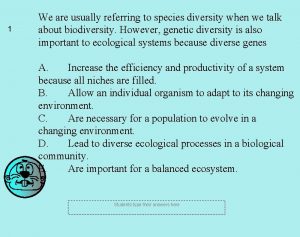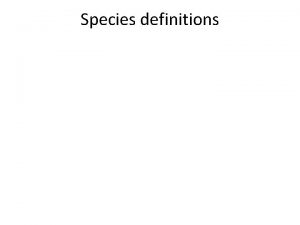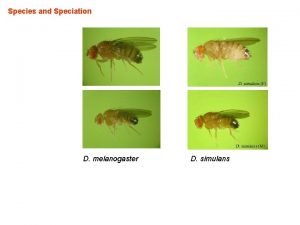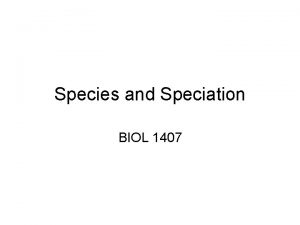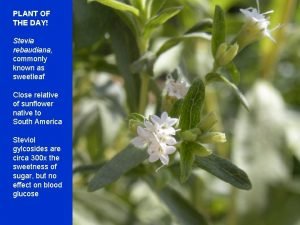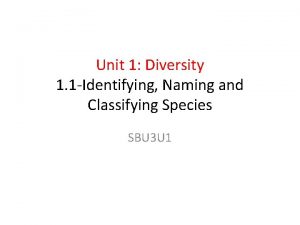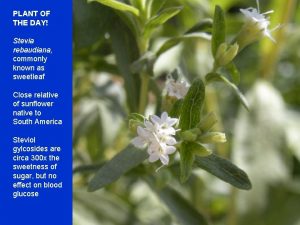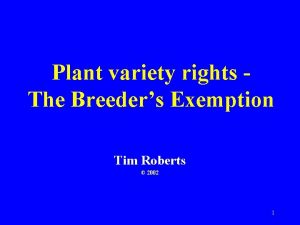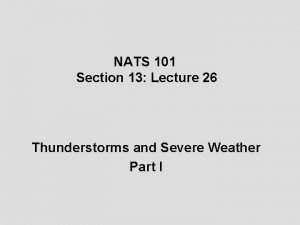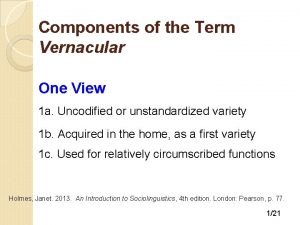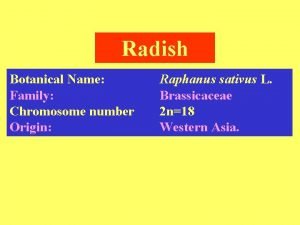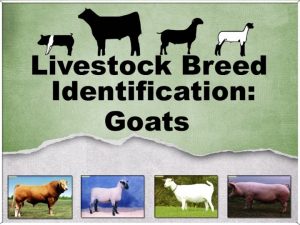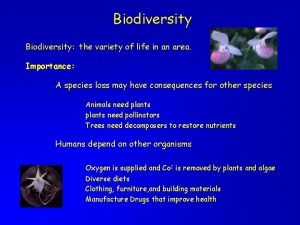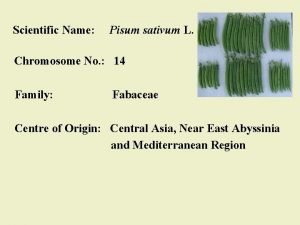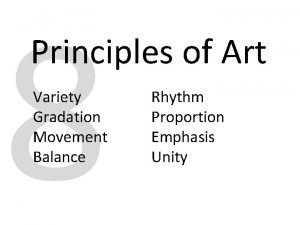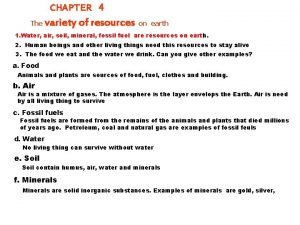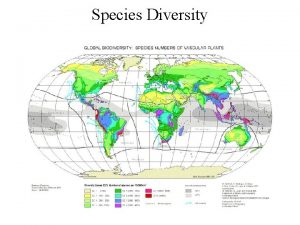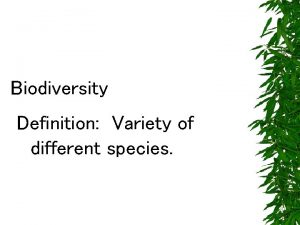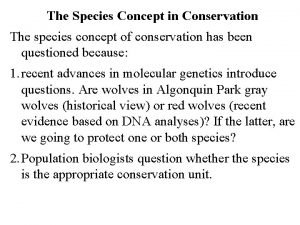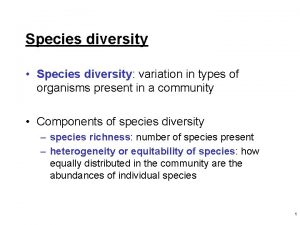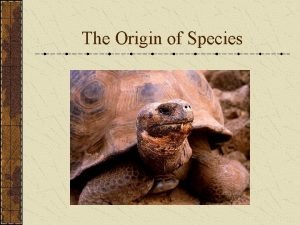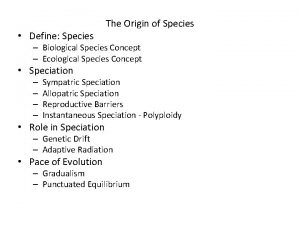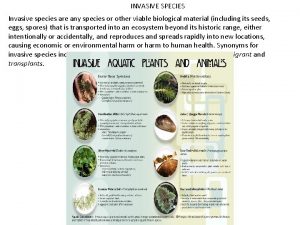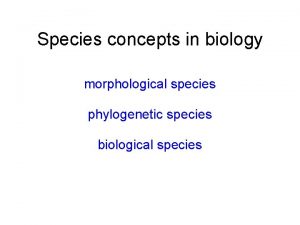Species diversity Concept of diversity Informally variety Wallaces


































![Quantifying b diversity • Whittaker’s index – b = (a+b+c)/{[a+c+b+c]/2} – 1 – = Quantifying b diversity • Whittaker’s index – b = (a+b+c)/{[a+c+b+c]/2} – 1 – =](https://slidetodoc.com/presentation_image_h2/ac9cd5f587cd3f68838718c8c10b0208/image-35.jpg)




























- Slides: 63

Species diversity

Concept of diversity • Informally … variety • Wallace’s traveler – A traveler in Amazonia encounters a species of tree (1 individual); If he looks for another member of that same species he will seek it for a long time, encountering many other species before he finds another. This is true for most if not all the tree species in Amazonia.

Concept of diversity • In contrast … cattail marsh – for one species, number of encounters between successive encounters with the same species will be small (often 0) • Intuitively, Amazon forest is more diverse than the cattail marsh

Diversity • Equivalent to – probability of interspecific encounter – average rarity • What determines these? – 1) number of species (S ) … species richness – 2) evenness, or equitability, or relative abundances (E )

Kinds of diversity • a diversity: variety of species within one community • b diversity: extent of replacement of species with changes in environment from place to place • g diversity: combination of a and b diversity

Numbers, measurements, etc. • S = number of species • N = number of individuals • ni = number of individuals of species i – i = 1, 2, 3, … , S • Si=1 ni = N • pi = ni / N = relative abundance of species i

Graphical representation of E Sn = number of species with abundance ni, Sn Sn ni ni

Quantifying evenness • (observed diversity / maximal diversity) for a given S • Calculate some measure of overall diversity (D) • Hold S constant and set relative abundances of all species to 1/S • Calculate Dmax= maximal diversity • E = D / Dmax

Diversity indices • Single number combining species number and evenness • >60 different formulas • differ in relative weight given to evenness or species number

Three examples • S-1=D 1 – gives 0 weight to evenness • Shannon-Weiner: - S i=1 pi ln(pi) = D 2 – intermediate weight to evenness • Simpson’s: 1 - Si pi 2 = D 3 – gives major weight to evenness • Used to compare communities

Imaginary communities: which is more diverse?

Different comparisons • Indices do not measure a single quantity • Diversity indices combine 2 inherently different quantities • Weights chosen are arbitrary • Indices are related in a complex way

General form of diversity indices • Average rarity = diversity – a community composed of many rare species is diverse – Rarity ( R (pi)) is a decreasing function of relative abundance (pi) R(pi) pi

General form of diversity indices Average rarity = S S ni (R (pi)) S =S N =D [A diversity index] pi (R (pi))

What is R ( pi ) ? Rarity indicated by number of encounters y with other species that occur between encounters of a given species encounters: i … j … k … m… j … x … z … i y=6 y is amenable to analysis via probability theory

From y to R ( pi ) • In general, probability theory yields the general function: R ( pi ) = (1 - pib ) / b • where b is a constant chosen by investigator

D = average rarity (a general diversity index) • D = S pi R( pi ) = S pi [ (1 - pib) / b ] • constant b that is chosen determines which of the diversity indices (S-1, Shannon, Simpson) results • as b increases, greater weight is given to evenness

Three diversity indices

Diversity indices • Shows that they are related • Differ in R( pi ) • Does not solve the problem… which weighting is correct • Solution: don’t bother with diversity indices • implies that diversity as a single thing doesn’t exist

Quantifying diversity • Report S – in a sample S depends on N – to compare samples of different sizes use rarefaction • Report E – many measures depend on S – choose those least dependent on S

Rarefaction • two samples of different N • lower N, lower S in the sample, regardless of S in the community itself • Rarefaction … estimating expected number of species in a sample of size n : • E (S )n

Rarefaction E (S)n = s S (N - ni)! 1 - n! (N - ni - n)! N = number of individuals in entire sample n = number of individuals in the subsample ni = number of individuals in species i N! n! (N - n) !

Example • Communities A and B • differ in S and N in sample • How many species are expected in B if only 16 individuals were sampled?

Example • N = 62, n = 16, ni = {10, 20, 2} • E (S )n = 0. 962 + 0. 999 + 0. 453 • = 4. 376 • i. e. , 4 or 5 species from community B • Even with rarefaction, community B has greater species richness

When to use rarefaction • If NA and NB are close, rarefaction makes little difference • Rule of thumb: if NA / NB > 10 or < 0. 1 then use rarefaction

Evenness • Quantification should be independent of S • Smith & Wilson 1996 tested 14 indices • Most, including common ones, fail – note: Morin p. 18 J = H’ / Hmax – = [ -S pi ln pi ]/[ln S ] – one of the worst for independence of S

Evenness • example: Modified Hill’s Ratio • claimed to be less dependent on S than most • E = {(1 / S pi 2) - 1} / {exp(-S pi ln pi ) - 1} • dominance by 1 species … E = 0 • maximal evennesss … E = 1 • Smith & Wilson show it is independent of S only for S > 10

Evenness • among those that are independent of S: E 1/D = 1 / (S S pi 2) & Evar = 1 – (2/p){arctan[VAR(ln(ni))]} = 1 – (2/p){arctan S[ln(ni) – Sln(ni)/S]2 / S} • seem to be good choices

Evenness • E 1/D … simple • Evar … derived from variance, hence derived from the conceptual basis of evenness

Dominance-diversity plot

Data for dominancediversity plot

b diversity • Extent of replacement of species from place to place • May be equated to dissimilarity between locations – If all locations have identical species list, b diversity is 0

b diversity • Whittaker defined b diversity as; – b=g/a • Where g is regional diveristy • And a is local diversity • However – Debate about additive vs. multiplicative relationship of a b g • g=ab vs. g=a+b

Quantifying b diversity • Inversely related to similarity – Two samples • a=species unique to community A • b=species unique to community B • c=species shared • Jaccard’s similarity J = c/(a+b+c) • Sørensen’s similarity Ø = 2 c/(a+c+b+c) • 1 -similarity = distance or turnover
![Quantifying b diversity Whittakers index b abcacbc2 1 Quantifying b diversity • Whittaker’s index – b = (a+b+c)/{[a+c+b+c]/2} – 1 – =](https://slidetodoc.com/presentation_image_h2/ac9cd5f587cd3f68838718c8c10b0208/image-35.jpg)
Quantifying b diversity • Whittaker’s index – b = (a+b+c)/{[a+c+b+c]/2} – 1 – = (Stotal / S) -1 • Works with >2 samples. • NOTE: none of these weight species by abundances – (i. e. , none incorporate evenness)

b diversity • Thorough mathematical treatments of b diversity – Tuomista 2010 a, b – Jost 2007 • But the more interesting question is why do we care about b diversity? – component of biodiversity that is at least in part independent of a diversity – Relationships of biotic variables to a b g are not consistent

Diversity Productivity Stability

How is S related to primary productivity? • Small scale – fertilize plots - plant diversity declines – Tilman 1996 (Fig. 2 c) • Lakes – Eutrophication - diversity declines

species Unimodal diversity-productivity gradients productivity

species Monotonic diversity-productivity gradients productivity

species Unimodal can look like monotonic productivity

Why should diversity decline with productivity? • High productivity reduced spatial heterogeneity in resources • Spatial heterogeneity fosters diversity – reduces competitive exclusion – variance in resource ratio hypothesis (VRR) – each species does best on a particular ratio of resources – e. g. , plants and soil nutrients

Spatial heterogeneity of resources • Tilman’s fertilizer experiment – add N to soil – changes resource ratio – as N goes up greatly, ratio of N to other nutrients gets larger and more constant • Varying resource ratios do foster coexistence among plants – other taxa?

VRR Hypothesis • Assumes – species occur in patches – competition is local – resource competition • Generality? – Rodents? – Benthic invertebrates? – Tropical mammals?

Scale • Local plots Continental areas – relationships of diversity to productivity differ – Chase & Leibold 2002; Gross et al 2000 – Unimodal patterns at local scale – Monotonic* patterns at regional scales – Implication: b diversity increases with productivity * Increasing

Scale • Same mechanism at all scales? – VRR works best at local plot scale – Applicability at larger scales unknown – Does natural variation in productivity affect species the same way as experimental manipulation?

Alternative interpretations (Abrams 1995) • Challenges interpretation of monotonic patterns as artefacts of inadequate sampling • Questions the assumption that unimodal patterns must be due to competition – need for experimental data on competition – experimental test of VRR • Alternative hypotheses predict monotonic relationships

How is S related to stability? • What is stability? • Mathematically, a stable equilibrium… – for variables i = 1 to n: d. Xi / dt = 0 – if the system is perturbed away from equilibrium (X 1, X 2, … Xn)* it returns • GLOBAL STABILITY: returns from any perturbation • LOCAL STABILITY: returns from a limited set of perturbations

Ecological stability has multiple facets • Constancy: lack of change in a variable • Resiliency: continued functioning despite change • Recovery: return to original state – elasticity greater if return in more rapid • Inertia: resistance to change via perturbation • Persistence: survival of the system despite changes (no extinctions)

Ecological stability • Populations may be stable in number of individuals • Communities may be stable in: – species number – total biomass – Gross primary productivity – species abundance patterns

Why stability matters • Mathematically tractable, interesting • Value judgement … lack of change = good • Practical utility … we have an interest in exploiting populations, ecosystem services – HOWEVER: some desirable properties depend on inconstancy and periodic disturbance

Diversity Stability • Elton: Diverse or complex communities are more stable – Theory: simple models oscillations – Outbreaks of pests in simple agricultural systems – Population cycles in “simple” arctic – Lack of cycles in diverse tropics • Actual data few

Diversity Stability • Mac. Arthur: models of simple communities • Feeding relationships (food webs) SIMPLE COMPLEX

May (1973) • Used models of communities to test stability -complexity • Randomly assembled food webs • Simple: low connectance (trophic links / species) • Complex: high connectance • Complex webs less likely to be stable – Extinctions more common

Empirical study P C B • Lawler (1993): Experimental microbial communities – bacteria • (4 edible species) – protist bacteriovores P 1 P 2 C 1 C 2 • (1 -4 spp) B – protist predators • (1 -4 spp) – simple 3 -taxa chains vs. 5 or 9 -taxa communities P 1 P 2 P 3 P 4 C 1 C 2 C 3 B C 4

Lawler 1993 • Extinctions – 9 -taxa > 5 -taxa > 3 -taxa communities – consistent with May’s model results – diversity (or complexity) leads to instability – but population variation was not greater with greater diversity (for most of the species)

How did ecologists conclude complexity stability? • Elton – particularly concerned about human impact – simplification systems – need to preserve natural systems • Complexity and stability both valued • Assumed observed natural systems were stable (return to equilibrium)

Any resolution? • Complexity inconstancy – numbers of species change readily • Complexity resiliency – function despite change • Stability & complexity (or diversity) may be related, but not simply – abiotic stability or predictability may foster evolution of complexity

Tilman 1996 • Experimental manipulation of productivity – Soil N – Produces a range of diversities (S ) in plots • Diversity and productivity are related – How do plots respond to natural perturbations? • annual variation, particularly drought (1988) • Three measures of biomass – change in biomass pre-drought - peak drought – CV biomass over 10 years – CV biomass in non-drought years

Whole community response: Total biomass • All measures indicate greater stability with greater S – change in biomass lower with greater S – CV’s less with greater S • Mc. Naughton obtained similar results with respect to grazing as a disturbance

Tilman, Fig. 5

Individual species responses: Biomass • Averaged across species (39) • Lower stability of populations with greater S – CV’s greater with greater S – both drought and non-drought years • Population stability (average) decreases with diversity

Tilman, Fig. 9 A
 Ecosystem jigsaw activity
Ecosystem jigsaw activity Why is genetic diversity important
Why is genetic diversity important Which subject pronoun is used to address someone informally
Which subject pronoun is used to address someone informally Species
Species Species diversity:
Species diversity: Species diversity:
Species diversity: Biodiversity
Biodiversity Ecological speciation
Ecological speciation Phenetic species concept
Phenetic species concept Morphological species concept
Morphological species concept Horizontal gene transfer
Horizontal gene transfer Ecological species concept
Ecological species concept Gametic isolation example
Gametic isolation example Biological species concept
Biological species concept Morphological species concept
Morphological species concept Types of species
Types of species Genotypic cluster species concept
Genotypic cluster species concept Perbedaan selling concept dan marketing concept
Perbedaan selling concept dan marketing concept Real vs ideal self examples
Real vs ideal self examples Number and variety of pets
Number and variety of pets Ornithologist in a sentence
Ornithologist in a sentence 5 techniques in summarizing various academic texts
5 techniques in summarizing various academic texts Volume velocity variety and veracity
Volume velocity variety and veracity Emergent layer
Emergent layer Vary various variety
Vary various variety Ndsu corn variety trials
Ndsu corn variety trials Variety adj
Variety adj Sentence variety exercises
Sentence variety exercises Essentially derived variety
Essentially derived variety Eel sentence
Eel sentence Garden variety thunderstorms
Garden variety thunderstorms Coral reef fish
Coral reef fish Product variety and quality under monopoly
Product variety and quality under monopoly Holding a variety of investments to reduce risk
Holding a variety of investments to reduce risk High value deal seekers
High value deal seekers Vernacular variety
Vernacular variety A variety
A variety Process volume
Process volume Complex sentence starters
Complex sentence starters Nine principles of design
Nine principles of design Family name origin
Family name origin Variety of life on earth
Variety of life on earth Dr anbari
Dr anbari Bunch type groundnut
Bunch type groundnut Mooli ka botanical name
Mooli ka botanical name Variety refers to
Variety refers to Numerous variety
Numerous variety Example of fitt
Example of fitt Product variety marketing example
Product variety marketing example Variety harmony
Variety harmony Language
Language The variety of life in an area
The variety of life in an area Language
Language Refers to the variety of training a performer undertakes
Refers to the variety of training a performer undertakes Radiation interior design examples
Radiation interior design examples Palam triloki is a variety of
Palam triloki is a variety of Walter cannon observed that a variety of stressors trigger
Walter cannon observed that a variety of stressors trigger Gradation in art
Gradation in art Variety and variability
Variety and variability Combining sentences exercises
Combining sentences exercises Octopus shape poem
Octopus shape poem What image is this
What image is this Variety of resources
Variety of resources What is a biome? *
What is a biome? *




